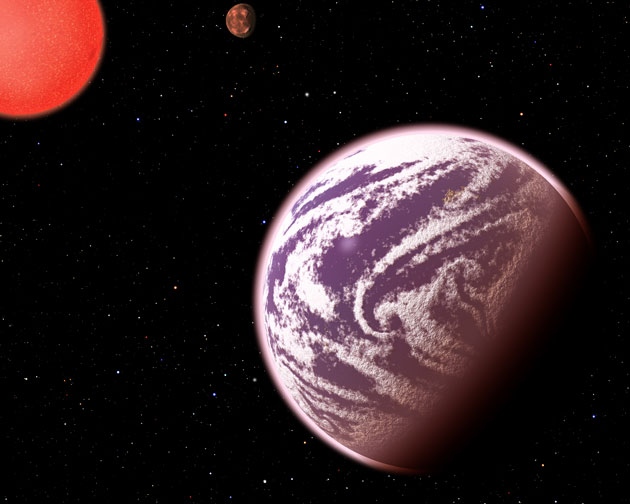Earth-mass exoplanet is no Earth twin

Gaseous planet challenges assumption that Earth-mass planets should be rocky.
Astronomers have discovered an extrasolar planet with the same mass as Earth, but the resemblance ends there. Not only is the planet too warm for liquid water to exist on its surface, but it also has a radius 60% larger than Earth, suggesting a vast, puffy atmosphere of hydrogen and helium.
“You’ve got a very small planet that is probably not rocky at all, and that’s frightening,” says Jacob Bean, an astrophysicist at the University of Chicago in Illinois.
What is scary, he says, is how the finding challenges the assumption that an Earth-mass exoplanet would have an Earth-like composition. With its thick atmosphere, the exoplanet is more like a scaled-down Neptune or Uranus, he notes. Its surprising density suggests that it will be even more important in future campaigns to measure both the size and the mass of exoplanets. Density, the ratio of mass and size, is known for only about 150 of the more than 3,000 known exoplanets.
“We can’t be sure that we have Earth 2.0 until we have both pieces of information,” says astronomer David Kipping of the Harvard‒Smithsonian Center for Astrophysics in Cambridge, Massachusetts, who announced the finding on 6 January at a meeting of the American Astronomical Society near Washington DC.
Kipping and his colleagues used NASA’s Kepler spacecraft to detect the planet, one of three orbs that closely circle a dim, red dwarf star some 60 parsecs (200 light-years) from Earth. Kepler normally measures only the size of a planet, which can be inferred by the amount of light it blocks each time it transits, or passes, in front of its parent star. But the planet, dubbed KOI-314c, orbits so close to one of its siblings, KOI-314b, that the gravitational tug of the two bodies periodically delays or advances the moment of their transit. These timing variations can be used to calculate mass.
KOI-314c, with an estimated surface temperature of 104 °C, circles its red-dwarf parent every 23 days. Its sibling, KOI-314b, is even hotter and has a closer-in orbit 14 days long. KOI-314b has a similar size to the Earth-mass planet but is about four times heavier.
But KOI-314c is the enigma. It is surprising how a planet only as massive as Earth could have enough gravity to retain such a vast atmosphere, something that disturbs Sara Seager, a theoretical physicist at the Massachusetts Institute of Technology in Cambridge. “I would want more precise measurements before having to accept the interpretation,” she adds. Because light from the parent star can filter through the planet’s thick atmosphere every 23 days, its composition should be ripe for study with the James Webb Space Telescope, scheduled to launch in 2018, says Kipping.
Kepler’s planet-hunting mission ended in May when its telescope could no longer be aimed precisely. Kepler researchers are now awaiting NASA’s decision on other uses for the craft (See “NASA ponders Kepler’s future”). A final verdict is expected in June.



 Creators of mankind
Creators of mankind Description of “Tall white aliens”
Description of “Tall white aliens” Where they came from?
Where they came from? About hostile civilizations
About hostile civilizations The war for the Earth
The war for the Earth “Tall white aliens” about eternal life
“Tall white aliens” about eternal life Video: “Nordic aliens”
Video: “Nordic aliens” Aliens
Aliens Alien encounters
Alien encounters The aliens base
The aliens base UFO
UFO Technology UFO
Technology UFO Underground civilization
Underground civilization Ancient alien artifacts
Ancient alien artifacts Military and UFO
Military and UFO Mysteries and hypotheses
Mysteries and hypotheses Scientific facts
Scientific facts


















